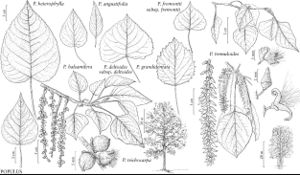Populus deltoides subsp. deltoides
Plants to 55 m. Winter buds usually glabrous. Leaves: blade base usually with 3–6 tubular basilaminar glands, apex short-acuminate, abaxial surface pilose at emergence; preformed blade with (6–) 12–20 (–30) teeth on each side; neoformed blade lengths usually distinctly greater than widths. Pedicels: lengths graded, shorter from base to apex, 1–13 (–17 in fruit) mm. Capsules with thin, flexible valves.
Phenology: Flowering Mar–Apr (fruiting Apr–Jul).
Habitat: Floodplains, low wet areas, secondary woodlands
Elevation: 0-400 m
Distribution

Ont., Que., Ala., Ark., Conn., Del., D.C., Fla., Ga., Ill., Ind., Iowa, Ky., La., Md., Mass., Miss., Mo., N.H., N.J., N.Y., N.C., Ohio, Okla., Pa., S.C., Tenn., Tex., Vt., Va., W.Va.
Discussion
Southern cottonwoods are nearly ubiquitous, although varying greatly in abundance, throughout the southeastern United States. They are among the fastest growing and largest trees in the region and are the basis for local poplar plantation forestry rather than hybrids used in other regions. Subspecies deltoides intergrades rather freely with subsp. monilifera up the Mississippi River drainage system, and traces of its morphological influence may be found as far north as Minnesota and Wisconsin (E. Marcet 1962).
Selected References
None.
